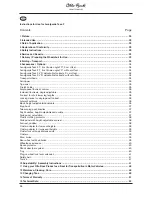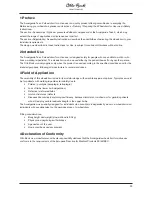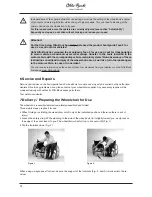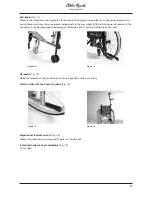
42
43
For repair and maintenance, you will need the following tools:
Allen wrenches, sizes: 4 mm, 5 mm, 6 mm
Open-end wrenches, sizes 10 mm, 12 mm, 19 mm, 24 mm
Screwdriver
Torque wrench
Tire lever
Be careful not to injure your fingers during adjustment and assembly.
When adjusting the settings, be sure to apply the exact torque specified for a given screw connection! If you do
not have of the proper tools (e.g. torque wrench), please contact your medical supply dealer.
Adjusting the wheel lock
To change the position of the rear wheels, first loosen the attachment screws of the wheel lock at the tube clamp
and push the wheel lock forward. Once the rear wheels have been mounted in the new position, the wheel lock
should be remounted so that when the wheel lock is not activated, the distance between the tires and wheel lock
bolts is 5 mm maximum (subject to technical changes, Fig. 40). Check the tire air pressure and the effectiveness
of the locking devices regularly. The air pressure is indicated on the side wall of the tire. It should be at least
3.5 bar (350 kPa). Be sure to use only original rear wheels with approved radial excursion with a maximum of
±1 mm in order to ensure satisfactory braking effect.
Make sure to firmly retighten all screws and nuts after making adjustments!
Figure 40
Figure 41
Adjusting the rear wheel adapter in the frame
(Fig. 41)
The further back the rear wheel is attached, the longer the wheelbase and the greater the wheelchair stability
(refer to "Wheelbase extension").
By attaching the rear wheel in a more forward position (only for trained wheelchair users), the maneuverability
of the wheelchair increases and the caster wheels can be lifted more easily to clear obstacles such as curbs or
steps.
• Please note: If the rear wheels are in their more forward position and the user’s body is not appropriately
positioned, the user may tip backward – even on flat ground!
• For untrained wheelchair users, children and when there are extreme adjustments to the rear wheel, an anti-
tipper is strongly recommended!
• For transfemoral amputees, the rear wheels must be shifted backwards!
• Loosen the cap screws (Fig. 41, items A, B) in the rear wheel attachment device until the rear wheel adapter
can be moved. Find a new position in the frame by inserting the lugs of the stop clamps (Fig. 41, item C) into
the desired bore hole in the frame. Firmly re-tighten the two screws (Fig. 41, items A, B).
Ensure that the left and right rear wheel adapters have the same horizontal position in the frame.
• Please note that due to the change in the rear wheel position, the angle of the caster axle in relation to the
ground can also change. This angle, however, should always be approx. 90°. The wheel lock must be re-
adjusted as well.
Make sure to firmly retighten all screws and nuts after making adjustments!
5 mm
A
C
B














































